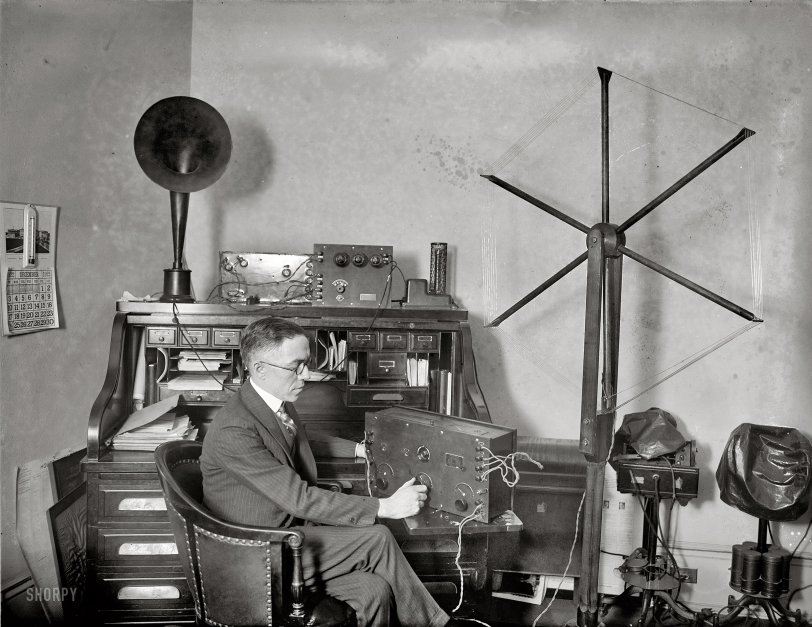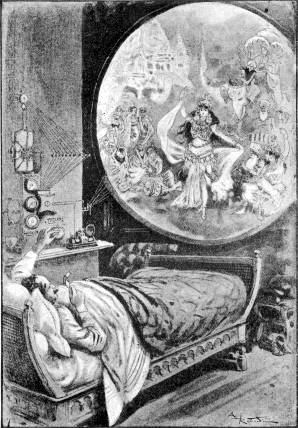


Framed or unframed, desk size to sofa size, printed by us in Arizona and Alabama since 2007. Explore now.
Shorpy is funded by you. Patreon contributors get an ad-free experience.
Learn more.

- Details, Details
- What's that building to the left of the tower?
- Coal Barges
- Bromo-Seltzer
- Inner harbor
- The Basin
- What a headache!
- Giant stepladder?
- Baldwin 62303
- Baldwin VO-1000
- Cold
- No expense spared
- Tough Guys
- Lost in Toyland
- And without gloves
- If I were a blindfolded time traveler
- Smoke Consumer Also Cooks
- Oh that stove!
- Possibly still there?
- What?!?
- $100 Reward
- Freeze Frame
- Texas Flyer wanted
- Just a Year Too Soon
- WWII -- Replacing men with women at the railroad crossing.
- Yes, Icing
- You kids drive me nuts!
- NOT An Easy Job
- I wonder
- Just add window boxes
Print Emporium
The Twiddler: 1922

Washington, D.C. December 19, 1922. "Rep. Vincent Morrison Brennan, Republican of Michigan, listening in on the proceedings of the House, with a receiving set." National Photo Co. Collection glass negative. View full size.
More than just twiddling
This is an interesting photo from a technical perspective.
The subject is far more that just a twiddler. He has an advanced radio receiving setup, but even more interesting are the two cylinder machines.
At the time early radio broadcasts included music transmissions of jazz and other music. Also electric cylinder recorders were not common until around 1925, but these devices are definitely electrically driven cylinder devices and I speculate that one or both are recorders. In which case this fellow could be involved in recording music received from a broadcast and then duplicating cylinders for sale or distribution.
More about the radio. The twiddler is tuning the valve radio located on the desktop. That involved tuning in the station and also tuning the input signal to maximise signal strength. The four connection top right on the receiver are for the A and B power supply voltages, these are coming from batteries in the box on the floor to the right of the desk. The bottom right connections on the receiver connect to the loop antenna on the stand. The receiver would power headphone by default. In the case however the audio output is connected to the valve audio amplifier on the top shelf, the output of which is connected to the electrically driven horn loudspeaker to the left. The unit to the right of the amplifier is housing what is almost certainly a power triode delivering heaps of power, perhaps around 2 watts. I a have already suggested, the output could also be fed to a cylinder recorder (very advanced).
Interesting; quite a leader, with regards to copyright issues and dilemmas only now being dealt with by the major music distribution companies.
Not yet the telephonoscope
Obviously this gentleman was a respectable politician listening to respectable material. But French scientist and sci-fi writer Camille Flammarion had a vision in 1894 of what such technology might lead to in his novel "La Fin du Monde" -- today's couch potato watching the dancing girls on his plasma screen. Sometimes it takes a long time to bring the technology to fruition.

Hark! A Fark!
Radio 4 the Peepul
The prescience of this writer (R.T.S.) to the ramifications of broadcasting congressional debate amazes me. Apparently the allure that an open microphone holds over our elected officials was set in place nearly a century ago.
Washington Post, Mar 13, 1922Men And Affairs
By R. T. S.
The proposition of Representative Vincent Brennan, of Ohio, to equip the United States Capitol with a radio "broadcaster" capable of carrying the House and Senate debates to all parts of the county so that the "peepul" can know what is going on every day in Congress is causing something akin to alarm in wireless circles. Already the question is asked as to what the other waves have ever done to Congress to be inflicted with such a daily output of oratory? And what chance would the air have to carry anything else once it was freighted with the congressional debates?
The problems which arise in connection with the project are simply stupendous. How could the Senate and House both be in wireless operation at the same time without serious "interference?" Certainly it would be necessary to pitch the debates on different planes - different wave lengths. And which would claim the higher plane? Furthermore, if all the debates were broadcasted and some several hundred thousand of persons were listening spellbound at the old family fireside, how could you ever get either representative of senator to stop talking? Congress would be session for 24 hours a day.
Certainly the wireless telephone has congressional possibilities, but if there has been too much talk, with only the Congressional Record as a medium of complete expression, what in the world would happen with a lot of radio sets tuned to a concert pitch and rearin' to go?
Cylinder dictation machines
Concerning Bob's question- I'm pretty sure those are cylinder dictation machines, similar to early Edison phonographs. The "cans" beneath are containers for the cylinders.
More about them here.
Two rightmost devices
Are they dictating phonographs?
re "Vertical cage"
I think Fred and Zach are talking about two different things. The large wagon-wheel thing is indeed a directional loop antenna. But Zach was referring to the smaller cylinder atop the desk that enclosed a resistor used to drop the line voltage to a low voltage for the tube filaments. Later transformers were used to do this more efficiently.
Tuned In
I suspect that this indeed was the portable version. Most radios of the period used lengthy aerials on the roof and a big copper earth spike in the garden.
I'm intrigued by the device to the right under the frame aerial, partially covered up. This seems to have a drive belt and a pulley. Is this some kind of motor generator set, to generate DC electricity from AC mains (or even DC mains)? It seems to have a rack for cans beneath it. The one to the right has a full set of cans. Are these electrolytic capacitors? Is this the power supply?
Don't be blinded by all the technology
He has a really nice rolltop desk, too.
Cable-Satellite Public Affairs Network
What we're seeing here is a beta C-Span.
Worth the effort?
From the looks of that contraption I think it would have been easier just to have gone to the House in person.
Ahead of his time
Congressman Brennan, who served only one term (he didn't run for reelection in 1922), introduced a bill to allow radio coverage of Congressional proceedings. It failed.
Not an AC adapter
The "vertical cage" is in fact a tuned directional aerial. The reason that some AC power supplies went off with a bang was the unreliability of early electrolytic capacitors (needed in the smoothing circuit).
Ahead of his time
The rightmost device atop the senator's desk is one of the first AC adapters. All radios in 1922 were battery powered, but the senator has his plugged into the wall via this adapter. They were prone to fire and explosion — pretty sure that vertical cage houses a massive wirewound resistor that would have had to have gotten mighty hot. Anyway, the senator's "receiver" setup sure was top-of-the-line in 1922. He must have been an avid wireless fan.
Outstanding processing
I downloaded the 1.7 mb tiff file from the LOC. It is a poor quality image. I spent a little time working on it. The processing you did to create the .jpg above is outstanding. How about a brief description of the steps you took to create the image?
[Thanks Doug. You are working from a different version of this image -- a print. Instead use the negative that the print was made from. Download the 25mb tiff. Then twiddle with the Shadows & Highlights filter in Photoshop CS4. - Dave]
While twiddling
The Congressman sits there waiting for Brian Lamb to be born.
Would you believe
This is the portable model!
























On Shorpy:
Today’s Top 5